Brownfields in EPA Region 5
EPA Region 5 manages Brownfields and Land Revitalization programs in Illinois, Indiana, Michigan, Minnesota, Ohio and Wisconsin.
This page has regional information. For general information about the Brownfields Program, visit www.epa.gov/brownfields.
Targeted Brownfields Assessments
Subtitle A of the Small Business Liability Relief and Brownfields Revitalization Act authorizes EPA to establish a program to perform Targeted Brownfields Assessments such as Phase I and Phase II Environmental Site Assessments at properties within Region 5 at no cost to local governments, quasi-governmental agencies and tribes. Information gathered from Targeted Brownfields Assessments gives local governments and prospective purchasers a better understanding of potential contamination issues at brownfields in their communities. EPA will characterize a brownfield to determine the nature and extent of the contamination. Results are provided to the community to assist them in redevelopment planning.
- Complete and send the Sample Request Letter (doc) (26 KB, 2024)
- Complete and send the TBA Eligibility Questionnaire (pdf) (189.94 KB)
- Complete, sign and send the TBA Access Consent Form.
- EPA Region 5 TBA Fact Sheet (pdf) (1.22 MB, 3/13/2025)
Region 5 TBA Contact
Melanie Sorman (sorman.melanie@epa.gov)
EPA Targeted Brownfields Assessment Program Lead
(312) 886-7185
Technical Assistance to Brownfields
The Technical Assistance to Brownfields Program provides free assistance to communities and stakeholders. Program providers serve as independent resources and can provide expert technical assistance and guidance for parties interested in acquiring, assessing, cleaning up and redeveloping brownfield properties. In Region 5, Kansas State University offers free technical assistance and training program services to EPA Brownfields Grant recipients and those seeking Brownfields Grants.
Grant Resources
- General Brownfields Grant Guidance
- Grantee Forms and Assessment, Cleanup and Redevelopment Exchange System (ACRES)
Region-Specific Resources
- Kansas State University Technical Assistance to Brownfields Communities
- Residential Demolition Bid Specification Development Tool Report and Fact Sheet
- Brownfields and Urban Agriculture: Interim Guidelines for Safe Gardening Practices (pdf) (2 MB)
- R5 Land Revitalization Resource Guide (pdf) (1.79 MB, July 2025)
Success Stories
Find out how EPA Brownfields Grant recipients are transforming properties across Region 5 to improve and protect the environment, boost the local economy and enhance communities now and for years to come.
State Cleanup Programs
Program Agreements
- Illinois (pdf) (641.45 KB)
- Illinois Superfund (pdf) (475.31 KB)
- Indiana (pdf) (461.7 KB)
- Indiana Superfund (pdf) (151.7 KB)
- Michigan (pdf) (509.15 KB, 2000)
- Michigan Superfund (pdf) (184.46 KB)
- Minnesota (pdf) (146.1 KB)
- Ohio (pdf) (13.46 MB)
- Ohio Modification (pdf) (266.31 KB, 2017)
- Wisconsin (pdf) (2.48 MB)
Federally Recognized Tribes with Brownfields Programs
- Bad River Band of Chippewa Indians, Wisconsin
- Bay Mills Indian Community
- Fond Du Lac Band Lake Superior Chippewa, Minnesota
- Grand Traverse Bay Band, Michigan
- Ho-Chunk Nation
- Keweenaw Bay Indian Community, Michigan
- Lac Du Flambeau, Wisconsin
- Leech Lake Band of Ojibwe, Minnesota
- Little River Band Ottawa, Michigan
- Little Traverse Bay Bands of Odawa Indians, Michigan
- Lower Sioux Indian Community
- Match-E-Be-Nash-O-Wish/Gun Lake, Michigan
- Menominee Indian Tribe of Wisconsin, Wisconsin
- Mille Lacs Band of Ojibwe, Minnesota
- Nottawaseppi Huron Band Potawatomi, Michigan
- Oneida Nation Wisconsin, Wisconsin
- Pokagon Band of Potawatomi
- Red Cliff Band of Lake Superior Chippewa, Wisconsin
- Red Lake Band, Minnesota
- Saginaw Chippewa, Michigan
- St. Croix, Wisconsin
- Sault Ste. Marie Tribe, Michigan
- White Earth, Minnesota
-
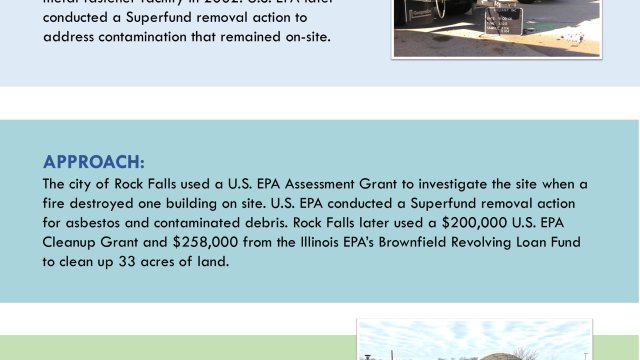
The city of Rock Falls used a U.S. EPA Assessment Grant to investigate the site when a fire destroyed one building on site. U.S. EPA conducted a Superfund removal action for asbestos and contaminated debris. Rock Falls later used a $200,000 U.S. EPA Cleanup Grant and $258,000 from the Illinois EPA’s Brownfield Revolving Loan Fund to clean up 33 acres of land. The site is now a hotel and riverfront park with 13 acres of greenspace, public art installations, an amphitheater, and utility plug-ins for food trucks. The project leveraged over $7.1 million in funding and 30 redevelopment jobs.
-
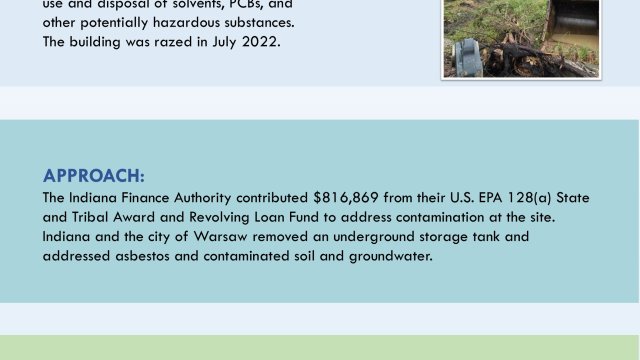
The Indiana Finance Authority contributed $816,869 from their U.S. EPA 128(a) State and Tribal Award and Revolving Loan Fund to address contamination at the site. Indiana and the city of Warsaw removed an underground storage tank and addressed asbestos and contaminated soil and groundwater. The Indiana Finance Authority issued an Indiana Brownfields Comfort Letter in April 2023. A 60-unit apartment complex was constructed on the site in May 2024. The complex was awarded $11 million in affordable housing tax credits by the state.
-
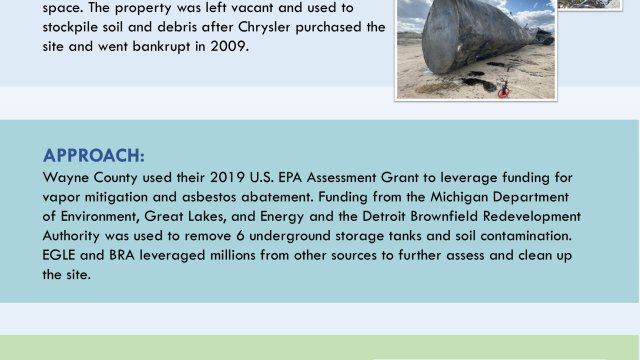
Wayne County used their 2019 U.S. EPA Assessment Grant to leverage funding for vapor mitigation and asbestos abatement. Funding from the Michigan Department of Environment, Great Lakes, and Energy and the Detroit Brownfield Redevelopment Authority was used to remove 6 underground storage tanks and soil contamination. EGLE and BRA leveraged millions from other sources to further assess and clean up the site. The site is now the 800,000 square foot Detroit Commerce Center. The $71 million project created 350 new jobs and restored a prominent brownfield in Detroit to productive use.
-
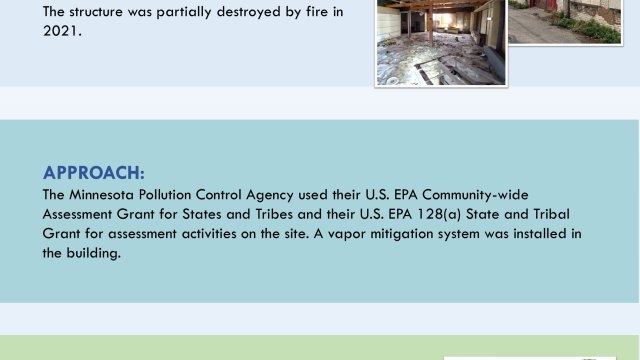
The Minnesota Pollution Control Agency used their U.S. EPA Community-wide Assessment Grant for States and Tribes and their U.S. EPA 128(a) State and Tribal Grant for assessment activities on the site. A vapor mitigation system was installed in the building. The Little Africa Plaza now contains a grocery store, retail shops, community space, and offices. The developer, African Economic Development Solutions, supported dozens of jobs and leveraged over $6.2 million in funding from outside sources to complete redevelopment.
-

The Ohio Environmental Protection Agency provided $63,000 from their Targeted Brownfield Assessment Program and U.S. EPA 128(a) State and Tribal Grant to address the site. Belomar Regional Council also supported the project with $65,000 from a U.S. EPA 104(k) Assessment Grant, and the Belmont County Land Reutilization Corporation leveraged funding for soil remediation from the Ohio Department of Development. The Great Stone Viaduct Historical Education Society took ownership of the site and constructed a paved walking path. The Society is also redeveloping a nearby brownfield site that was once used as a rail laydown yard for the Baltimore and Ohio Railroad. Visitors can now enjoy the outdoors and connect with local history.
-
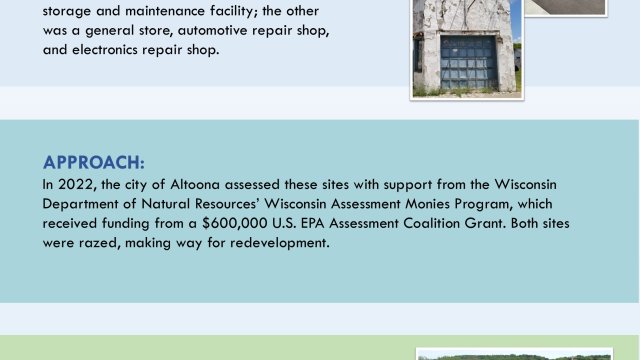
In 2022, the city of Altoona assessed these sites with support from the Wisconsin Department of Natural Resources’ Wisconsin Assessment Monies Program, which received funding from a $600,000 U.S. EPA Assessment Coalition Grant. Both sites were razed, making way for redevelopment. The Yard, a new micro-retail space, will open in summer 2025 with restaurants and commercial vendor space made from repurposed shipping containers. This project leveraged over $1.4 million in state funding and will create dozens of jobs and stimulate economic activity.
-
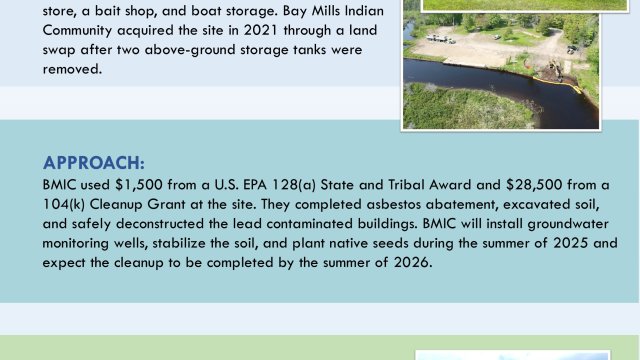
BMIC used $1,500 from a U.S. EPA 128(a) State and Tribal Award and $28,500 from a 104(k) Cleanup Grant at the site. They completed asbestos abatement, excavated soil, and safely deconstructed the lead contaminated buildings. BMIC will install groundwater monitoring wells, stabilize the soil, and plant native seeds during the summer of 2025 and expect the cleanup to be completed by the summer of 2026. BMIC plans to develop the site into an outdoor recreation space for fishing, boating, snowshoeing and camping. They hope that an outdoor retailer will also operate on site.
-
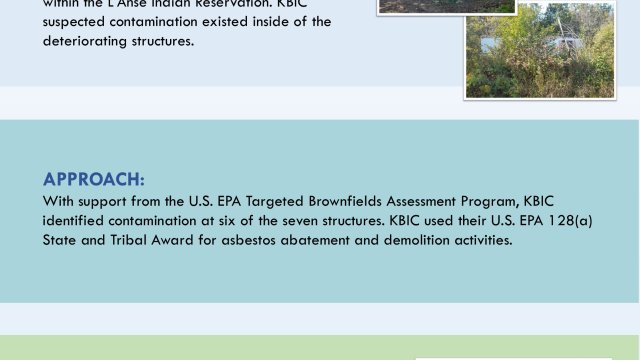
With support from the U.S. EPA Targeted Brownfields Assessment Program, KBIC identified contamination at six of the seven structures. KBIC used their U.S. EPA 128(a) State and Tribal Award for asbestos abatement and demolition activities. KBIC completed the cleanup of each site during summer 2023. The sites can now be redeveloped into Tribal member housing, recreational walking trails, or greenspace for medicinal plants.
Contacts
- John Jurevis (jurevis.john@epa.gov), Brownfields Coordinator (312-886-1446)
- Region 5 Brownfields Contact List
- Join the Region 5 Mailing List
